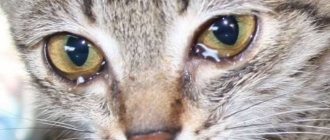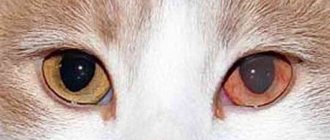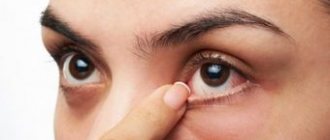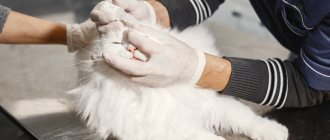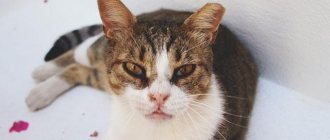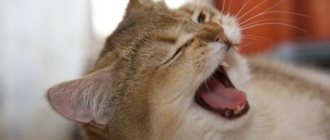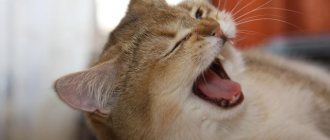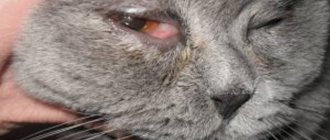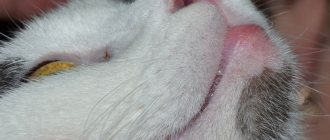If your Scottish kitten has watery eyes, it could be due to many factors. In addition to the physiological characteristics of these pets, which involves discharge from the visual organs, the problem is sometimes observed with the development of pathological conditions. That is why it is important for owners of Scottish cats to monitor their animals’ eyes and, if they are leaking heavily, contact a veterinary clinic.
Why do my Scottish Fold kitten's eyes water?
Tearfulness in Scottish Fold kittens is due to the physiological characteristics of the breed. The skull of the British, Persian and Scottish breeds has a flattened shape. As a result, the tear trough is shorter than in other cats. This is also accompanied by narrow tear ducts. Normally, all representatives of the cat family have transparent tear secretions. But in ordinary cats, the nasolacrimal passages are wide, and secretions come out through them. For the British they flow outwards.
Therefore, the release of a small amount of tear fluid is considered normal. This is especially noticeable after the animal sleeps. Kittens have stronger tearing than adult representatives of the British breed. Healthy tear secretions have a watery consistency.
Physiology of the breed
British cats and Scottish cats have a lot in common. Their similarity is not limited only to appearance. The muzzle of representatives of these breeds is shortened, as a result of which the functioning of the nasolacrimal ducts, which are responsible for controlling the flow of tears after moistening the cornea, is impaired. The remaining intraocular fluid that accumulates on the conjunctiva splashes out. Both Scots and Britons experience watery eyes most at an early age. However, a cat’s visual organs leak not only due to physiological characteristics. A number of pathologies may also be to blame for this.
Causes of lacrimation and methods of treatment
Tearfulness in the British is not always a feature of the breed. If the discharge becomes cloudy and thick, this indicates abnormalities in the pet’s health. Dark marks, as well as discharge of brown, yellow and green colors, are considered a deviation from the norm.
The causes of tear discharge can be mechanical damage or infectious diseases. At the first appearance of alarming symptoms, the animal must be taken to the veterinarian.
Pollution and mechanical damage to the eye area
The anatomical features of the British cause entropion. As a result, eyelashes and hair damage the mucous membrane. The result of untimely treatment can be not only loss of vision, but also the entire eyeball.
The Scots' tearfulness is also provoked by pollution, dust, and debris. The animal may be injured as a result of a fight or unsuccessful play. If the discharge turns brown, it means an infection has occurred. You need to contact a veterinarian. To alleviate your pet’s condition, you can provide him with first aid, following the basic rules:
- If the animal's eye is closed, it cannot be opened by force, as this can cause irreparable harm. It is necessary to treat not the eye itself, but the area around it. Movements should be smooth and soft.
- If possible, you should examine your pet's eye for the presence of a foreign object. Do not use sharp tools to remove it. Use a copious rinsing technique. If this does not help, you can use a syringe without a needle or a pipette. After the procedure, the mucous membrane should be treated with ointment (Tetracycline 1%). It is placed inside the upper eyelid.
- If severe swelling is observed, it is recommended to instill warm boiled water (36.3°C) every 5-10 minutes.
Glaucoma is also a non-inflammatory disease. Accompanied by increased pressure inside the eyeballs. The pet owner can diagnose the disease by dilated pupils. The eyeball becomes large and hard. The eye itself and the area around it become red due to the fact that the capillaries burst. It is impossible to cope with the disease without the help of a specialist. In some cases, glaucoma can be overcome with drug therapy. But if the reason lies in the dislocation of the lens, surgery will be required.
Sometimes the eyes become watery due to an allergic reaction. Severe tearing without any other symptoms may indicate simple dirt buildup. In this case, it is enough to rinse your pet’s eyes and clean them regularly to avoid complications in the form of purulent inflammation.
Infectious and other diseases
Inflammatory diseases include:
- Conjunctivitis. Accompanied by inflammation of the mucous membrane. The eyelids turn out and turn red. Swelling appears. The eye becomes cloudy and moves poorly. In some cases, purulent discharge is observed. After sleep, a yellow crust forms.
- Keratitis is inflammation of the cornea. Accompanied by severe itching and pain. The animal exhibits anxiety and photophobia. The corneas become cloudy and gray. White or yellow discharge oozes from the eyes.
- Keratoconjunctivitis. It develops if keratitis is not treated. Pathogenic microflora actively multiplies, and in addition to keratitis, conjunctivitis develops. The disease affects the entire organ of vision. If help is not provided in time, the disease will lead to death.
- Blepharitis is inflammation of the eyelids. There is severe swelling and redness. Purulent crusts form on the eyelids. If the disease is not treated, the scabs fall off and open wounds appear in their place. Then the eyelid begins to curl up and pus flows out from under it.
- Panophthalmitis is inflammation of all tissues. The Briton's eyes are watery, there is redness and swelling of the eyes, and copious purulent discharge. Eyelashes fall out. The advanced form of the disease is accompanied by fever and cramps of the whole body. The animal may lose an eye or die.
These diseases are caused by viral infections, fungi and parasites.
How to Diagnose Allergic Rhinitis
To identify allergic rhinitis, it is necessary to collect an allergic history:
- quality of living conditions, presence of mold in the apartment (house), presence of pets, house dust collectors;
- does the manifestation of the disease depend on seasonality;
- what is the situation in which the symptoms of the disease occur (in nature, in a damp room, etc.);
- is there a clear temporal relationship between allergen exposure and exacerbation;
- is there any improvement after stopping contact with the suspected allergen.
Currently, there are a number of methods for laboratory diagnosis of the disease that help to create a complete picture and make an accurate diagnosis. Laboratory diagnostics includes the following methods:
- clinical blood test;
- X-ray of the nasal cavity and sinuses;
- skin tests and provocative nasal texts (allergy testing);
- cytological examination of nasal secretions;
- examination of nasal discharge for the presence of microflora;
- anterior rhinoscopy;
- endoscopic examination of the nasal cavity;
- computed tomography of the nasal cavity and paranasal sinuses;
- anterior rhinomanometry.
Rules for cleaning a cat's eyes
You need to clean your cat's eyes by following simple rules:
- Before carrying out manipulations, you should thoroughly wash your hands to prevent any infection from entering the pet’s body.
- It is necessary to wipe in the direction from the outer edge to the inner. If the pet is healthy, soak a cotton swab in warm water or weakly brewed tea. If the cat is sick, use chlorhexidine or other disinfecting solutions.
- The solution should be warm, but not hot.
- Wipe each eye with a separate cotton pad.
Therapy methods
Treatment primarily depends on the underlying cause of your cat's watery eyes. If the phenomenon is provoked by a physiological factor and a peculiarity of the breed, then the pet’s eyes should not be treated.
At home, when the disease develops, the following remedies are used to treat the eyes:
- tetracycline ointment;
- Levomycetin drops;
- Furacilin;
- Sulfacyl sodium;
- Albucid;
- solution of potassium permanganate (weak).
The veterinary pharmacy sells special medications.
The following drugs are considered effective:
- Diamond eyes;
- Phytoelite;
- Iris.
To treat your eyes, you need to wipe them with cotton wool in the direction from the outer to the inner corner. If medications used for 2-3 days are ineffective, the cat needs to be shown to a specialist .
In addition to eye treatment, treatment should be aimed at eliminating the underlying cause that caused this symptom.
If the pathology is caused by worms, anthelmintic drugs are used. Antibacterial agents are used for various infections. Watery eyes caused by allergies are treated with antiallergic medications.
Traditional methods of treatment
What to do if you don’t have any medications on hand, and your cat’s eyes are watering? In this case, traditional therapy recipes are used. These include decoctions of medicinal plants.
Herbs used are:
chamomile;- marigold;
- calendula;
- green tea;
- sage;
- St. John's wort.
They help eliminate crusts containing pus after the cat wakes up, relieve the inflammatory process, and inhibit the growth and reproduction of pathogens.
Prevention of lacrimation and hygiene of kitten eyes
To avoid negative consequences, you need to carefully monitor your pet’s condition and regularly take preventive measures:
- keep household chemicals out of the reach of animals;
- do not allow various aerosols to come into contact with the mucous membrane (for example, automatic air fresheners);
- while cleaning the room, the cat should be locked in another room;
- Regularly wipe your pet's eyes.
If your animal has unusually excessive lacrimation, you should contact your veterinarian.
All information posted on the site is provided in accordance with the User Agreement and is not a direct instruction to action. We strongly recommend that before using any product, you must obtain a face-to-face consultation at an accredited veterinary clinic.
Manifestations of pathology
Before treatment, the animal’s condition should be assessed, so pay attention to the duration and nature of eye discharge, the presence or absence of other symptoms.
Signs may be as follows:
profuse lacrimation;- swelling around the eyes;
- brown, green and yellow discharge;
- impurities of pus in the discharge.
A Scot with pathology may constantly rub his eyes.
In some cases, symptoms include:
- hyperthermia;
- copious nasal discharge;
- drowsiness;
- changes in habitual behavior;
- apathy;
- pet anxiety;
- cough.
If symptoms appear that are not normal, you should consult your veterinarian.
Diagnostic procedures
Discharge from the eyes of cats of brown color and other shades should not be ignored, since without timely diagnosis and the necessary treatment, there is a high probability of complications and deterioration in the pet’s visual function. As soon as the owners notice that the cat’s eyes are watering, dark discharge has appeared around the visual organs and other unpleasant symptoms, they should contact a veterinarian. To make an accurate diagnosis and clarify the nature and source of pathological exudate, the specialist prescribes a series of laboratory and instrumental examinations. The cat's owner is asked about the animal's diet when purulent discharge or other unpleasant signs of illness occur.
Complex diagnostics includes the following manipulations:
- Schirmer test to determine the quantitative content of tears in a cat;
- measurement of intraocular pressure;
- blood test to identify pathologies of viral and bacterial origin;
- cytological examination of scrapings obtained from the ocular cornea;
- PCR reaction;
- endoscopy of the nasal passages.
If the specialist was unable to determine the source of the cat’s discharge in the eye area and select treatment, then ultrasonography and dacryocystorhinography are additionally performed. In rare cases, an X-ray of the skull is performed.
